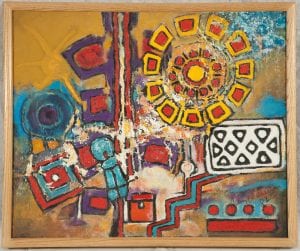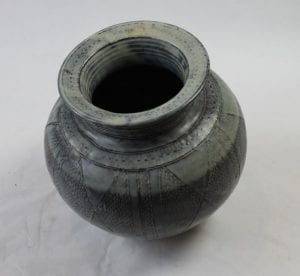Documenting the British Empire and Commonwealth Collection
Posted on by Lauren MacCarthy.
by Frances Davies, Documentation Assistant
There’s always plenty of behind-the-scenes work happening at the museum. Collections staff are often to be found busy beavering away in stores ensuring our objects are correctly documented and cared for.
This is the bedrock of museum work and essential to ensure we understand exactly what we have and why we have it.

Untitled Study, by Aubrey Williams. Oil on canvas © The Estate of Aubrey Williams
Which is why, for the past year, I’ve been improving the documentation for the British Empire and Commonwealth object collection.
The collection of 8,000 or so items was transferred to us back in 2012 following the closure of the museum at Temple Meads. It consists of objects which represent the people and industry of the former Empire and Commonwealth, along with objects collected from British people working in the Empire.
Much of this project has involved working in an (often chilly!) off-site storage facility working through the collection shelf by shelf, box by box and carefully auditing each item.
Along the way, we have needed to repack many of the items into new acid free boxes so they are better supported and protected. We’ve also flagged up items that might contain hazardous materials – for example, arsenic in taxidermy specimens or asbestos in old film projectors.
Details about the object are then updated on EMu, our collections management system. Built especially for museums, EMu is a sophisticated and dynamic database which does a lot of whizzy things… but at its most basic helps us to record details about an artefact and its lifecycle at the museum. We also use it to feed content to our website and our collections online.
In fact, our target is to improve the catalogue records of this collection so that we can upload more objects for viewing online. Another aim is to have more of the collection on display rather tucked away in storage.

Pot by Ladi Kwali
There are some real treasures in the collection such as ceramics by the Nigerian potter Ladi Kwali and paintings by Guyanese artist Aubrey Williams.
Some of the fantastic costume and textile is already on display in our Fabric Africa exhibition (on until 19 May 2019). In the future, we hope to develop and use the collection further by involving and working collaboratively with local and source communities, and academia.
There is much untapped potential within it to tell stories from multiple perspectives, especially from the viewpoint of those colonised, about an emotive and challenging chapter in British history.
3 comments on “Documenting the British Empire and Commonwealth Collection”
Please could you let me know what has happened to ´The Pamodzi Quilt’ , which was donated by me (Dr.Diane Doble Leemans) on behalf of all its creators to the Commonwealth Museum when at the Temple Meads site. I was asked to enquire what had happened to it after the Commonwealth Museum dissolved. I made many enquiries but was sent from pillar to post over a period of three to four years. It would seem there has been a sea change in management of the Bristol Archives in the interim and hopefully this historically valuable hanging will have come to light again.
Any information you can relate about this artefact will bring us all a great deal of relief.
Sincerest regards,
Diane Doble Leemans
Further to my email sent on 1st March 2020 at 12.04am, I am sending further details of the artefact, ´The Pamodzi Quilt’ below:
PAMODZI QUILT 1990-1992
‘The Pamodzi Quilt’ community project 1990-1992 at St Barnabas Community CE VC Primary School, Montpelier, Bristol.
It was funded by the WEO (Workers Educational Society, a small Church of England fund, and a generous extension fund from Hyacinth Hall MBE who was the first black Head in Bristol.
Radio Bristol highlighted the project and advertised for sewing materials, sewing machines, irons, boards, and remnants of material. The Quilt involved adults (parents, careers, staff and children of the St Barnabas Community School). In return for 2 years of free dressmaking and tailoring classes for adults the participants developed and created the Quilt.
The project was run as a co-operative. I was the Project Leader, and employed a dressmaker, a tailor, and a Crèche Worker. We each received the same payment per session.
For the parents and carers the workshops changed lives particularly in terms of growing confidence and self esteem, cultural understanding, awareness of cultural roots through design, pattern and textile developments through time. Furthermore changes in personal expectations upon individuals lives and the wellbeing and involvement of the relationships between children and their parents/carers were significantly expressed by the participants.
The ‘Pamodzi Quilt’ was exhibited in the Bristol Museum and Art Gallery in 1992 for an Autumn season. It was then moved to the Faiths & Beliefs Resource Centre, All Saints Church off Corn Street. During its time there, The Pamodzi Quilt was taken by the Quilters’ Guild to Goldsmiths College, University of London for an International Quilt Conference concentrating on making Cultural Democracy’, which also had a film showing of the biggest Quilt in the world, the AIDS Quilt in Washington, D.C. It was insured by the Director of the Quilters’ Guild for £2000.00 during its transfer in the late 1990s.
A new director of the Resource Centre at All Saints church, off CornStreet misunderstood the ´gentlefolks’ agreement between The All Saints church and St. Barnabas Primary School, C.E.V.C. Sadly the highly valuable work was bundled into a plastic carrier bag, returned to the school where it was stuffed into a storage cupboard.
I was contacted by an alarmed member of staff at the school to take the The Pamodzi Quilt’ into safekeeping. Discussions were held concerning our next moves for the PQ. I approached the Empire & Commonwealth Museum who welcomed the artifact and its attachments. They were delighted with the acquisition and its teaching role at the museum.
Then the Empire & Commonwealth Museum at Temple Meads exhibited and loaned it our for educational purposes; mainly for colleges and university departments for teacher education.
When the Commonwealth Museum closed The Pamodzi Quilt disappeared into Bristol City Council’s hands. I enquired many times but nobody would take responsibility over where it was archived. To reitterate this was a co-operative venture that truely changed lives positively.
Dear Diane,
Thank you for your enquiry. My apologies that you have been investigating the whereabouts of the quilt for such a long time without any result. The former British Empire and Commonwealth Museum collection was transferred to Bristol City Council in 2012 but it is only in the past two years that we have had the funding and staff to work on the collection and conduct a full audit of it. I am glad to say that we have the quilt safe and sound in our store. I am Documentation Assistant for the collection and would be happy to help further – my email is [email protected] Look forward to hearing from you. Best wishes, Frances